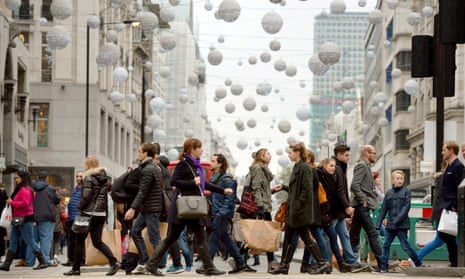All things considered, it could hardly have gone better for Britain’s retailers in 2016. Shops and online outlets were fully braced for a big hit to activity in the period after the EU referendum but it didn’t happen. Consumers spent in the summer. They spent in the autumn and they spent at Christmas too.
That spree is over. Retailers are going to find life tougher in 2017. Those facing the prospect of higher business rates alongside a dip in demand will experience a painful double-whammy.
Three factors explain why the pundits who confidently predicted carnage in the high street after the Brexit vote were wrong: consumer psychology; policy changes; and the economic fundamentals underpinning consumer demand.
Taking those points in reverse order, spending was supported by rising employment, low interest rates and rising real incomes. The big slump in oil prices at the end of 2015 had pushed down inflation and reduced fuel bills. Individuals were getting better off, had lost their fear of being made redundant, and had more money left over when the essentials were paid for.
These benign conditions became even more conducive to spending when the Bank of England stimulated the economy in early August, something it was always likely to do once Britain had voted to leave. The idea that Threadneedle Street would sit back and do nothing was for the birds.
Not that consumers needed much encouragement. The 52% who voted for leave spent because they were celebrating; the 48% who voted for remain spent as a form of retail therapy. Either way, the evidence is that people quickly got on with their lives.
Strong consumer spending was the reason the economy grew by 0.6% in both the third and fourth quarters of 2016. Activity was especially strong in November, but then fell back sharply in December. A further small fall in January ran counter to the City’s expectations and has left a strong impression that the party’s over.
This is probably true, even though some caution needs to be taken with the retail sales data. The figures are subject to seasonal adjustment to take account of the fact spending rises strongly in November and December before collapsing in January. The raw numbers from the Office for National Statistics show that there was a 13% rise in the value of retail sales (excluding fuel) between November and December followed by a 30% drop between December and January. Getting the seasonal adjustment right with these sorts of monthly gyrations is quite tricky and has been made harder by the recent popularity of Black Friday in November, when retailers offer early Christmas bargains. This has had the effect of bringing forward spending that would normally take place in December.
But it is also likely that the prospect of higher inflation prompted consumers to buy big ticket items in 2016 that they would otherwise have put off until 2017. To that extent, some of the growth seen last year has been borrowed from the future.
That’s rational behaviour, because inflation doubled to 1.8% between October and January and is certain to go higher over the months ahead. So far, the pick-up in the cost of living has been the result of the global rise in oil prices but retailers are also struggling with the higher prices paid for imports as a result of the post-referendum fall in the pound. Tough competitive pressures and the current softening of demand mean that only part of the increases in costs will be passed on but consumers are still going to feel the impact. In July and August last year, inflation was running at 0.6% and earnings were going up by 2.5%. Annual inflation will be running at 3% before long and unless wages start to rise real incomes will start falling.
If the past was any guide to the present, wage inflation would already be accelerating. The last time unemployment was as low as it is now was in 2005 when average earnings were growing at annual rate of 4%. Currently, they are increasing at about 2.5%.
For a while, this weakness in wage growth could be explained as a temporary response to the savage recession in 2008-09. Workers sacrificed earnings in order to prevent being laid off. The result was to spread the pain: a much smaller increase in unemployment but falling living standards for those in work.
But this interpretation is starting to look a little threadbare. As might have been expected, the rate of earnings growth fell sharply during the period when the economy was contracting. Output collapsed by about 6% over six quarters in 2008-09 and by the time growth had bottomed out earnings growth had fallen to 2%.
Yet it continued to fall even after recovery began. By 2013, earnings growth had slipped to 1% and it remained there well into 2014 even though by that time the jobless rate had dropped from 8% to 6% and was falling fast.
When earnings growth did at last start to pick up in late 2014 the expectation was that the upward trend would continue. But that didn’t happen. Wage inflation reached 2.5% in early 2015 and has remained there ever since.
Britain should be at the point where earnings growth starts to rise. Productivity has started to improve, inflation has picked up from unusually low levels, the number of workers resigning in order to move to a new job has reached a post-crisis high and there are plenty of job vacancies.
That should ensure some pick-up in earnings growth this year, but the improvement is likely to be modest and that means earnings will struggle to keep pace with prices. As a result, consumer spending will be squeezed and growth more dependent on the performance of exports. Retailers will only have another bumper year if wage inflation picks up markedly and that looks improbable.
Economists have been arguing about whether there is a strong relationship between wages and unemployment ever since Bill Phillips published his seminal paper on the subject in 1958. Looking at data from 1861 to 1957, Phillips found that when unemployment came down wage inflation went up and vice versa. The Phillips curve was born, became fashionable in the 1960s and then fell out of favour in the 1970s when, in the era of stagflation, unemployment and inflation both rose.
Over the years, it has become clear that there is a link between unemployment and wage growth, although not quite the neat long-term relationship that Phillips detected. Falling unemployment eventually leads to wage inflation but the jobless total has to fall a long way for workers to be able to exert any real bargaining power. There has been a structural change in the labour market that leaves the peak in wage inflation lower in each economic cycle.

